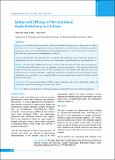Please use this identifier to cite or link to this item:
https://hdl.handle.net/20.500.14356/1661Full metadata record
| DC Field | Value | Language |
|---|---|---|
| dc.contributor.author | Dongol, Udaya Man Singh | - |
| dc.contributor.author | Limbu, Yugal | - |
| dc.date.accessioned | 2023-05-17T10:24:10Z | - |
| dc.date.available | 2023-05-17T10:24:10Z | - |
| dc.date.issued | 2017 | - |
| dc.identifier.citation | Singh DongolU. M., & LimbuY. (2017). Safety and Efficacy of Percutaneous Nephrolithotomy in Children. Journal of Nepal Health Research Council, 15(2), 130-134. https://doi.org/10.33314/jnhrc.v15i2.1050 | en_US |
| dc.identifier.issn | Print ISSN: 1727-5482; Online ISSN: 1999-6217 | - |
| dc.identifier.uri | http://103.69.126.140:8080/handle/20.500.14356/1661 | - |
| dc.description | Original Article | en_US |
| dc.description.abstract | Abstract Background: Renal stone disease is a common problem in children in developing countries. Its prevalence in children varies from 5% to 15%. It is suggested that anatomic abnormalities, recurrent urinary tract infections, metabolic disturbances, dietary and environmental factors are the predisposing factors.The aim of this study is to evaluate the safety and efficacy of percutaneous nephrolithotomy in children. Methods: Between May 2012 and Dec 2016, 25 children with renal stone diseases underwent percutaneous nephrolithotomy and were evaluated for stone free rate, complications, blood transfusion rate, sandwich therapy, etc. Results: The mean age of children was 9.3 years (7-15 years) and the mean size of the stone was 20 mm (13-27 mm). The anatomical location of stone was important in terms of stone clearance. Three patients needed blood transfusion. The overall stone free rate was 88% before discharge. Three patients had residual stones and were treated with extracorporeal shockwave lithotripsy. Complications included fever, haematuria, ileus and urine leak. No major complications were noted. There were no significant differences in haemoglobin and creatinine levels before and 12 hours after the surgery. Conclusions: Percutaneous nephrolithotomy (PCNL) can be considered a safe, effective and feasible modality of treatment for children with an average of 2 cm sized renal stones. Keywords: Extracorporeal shock wave lithotripsy; percutaneous nephrolithotomy; retrograde intrarenal surgery. | en_US |
| dc.language.iso | en | en_US |
| dc.publisher | Nepal Health Research Council | en_US |
| dc.relation.ispartofseries | May-Aug, 2017;1050 | - |
| dc.subject | Extracorporeal shock wave lithotripsy | en_US |
| dc.subject | Percutaneous nephrolithotomy | en_US |
| dc.subject | Retrograde intrarenal surgery | en_US |
| dc.title | Safety and Efficacy of Percutaneous Nephrolithotomy in Children | en_US |
| dc.type | Journal Article | en_US |
| Appears in Collections: | Vol 5 No 2 Issue 36 May-Aug 2017 | |
Files in This Item:
| File | Description | Size | Format | |
|---|---|---|---|---|
| 1050-Article Text-2325-2-10-20170910.pdf | Fulltext Download | 229.07 kB | Adobe PDF |  View/Open |
Items in DSpace are protected by copyright, with all rights reserved, unless otherwise indicated.
